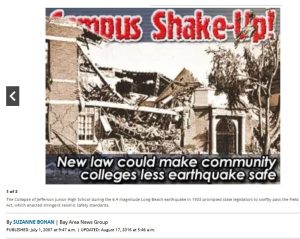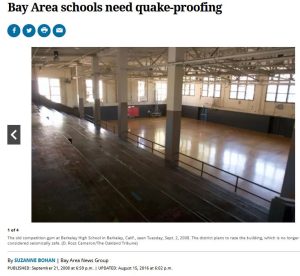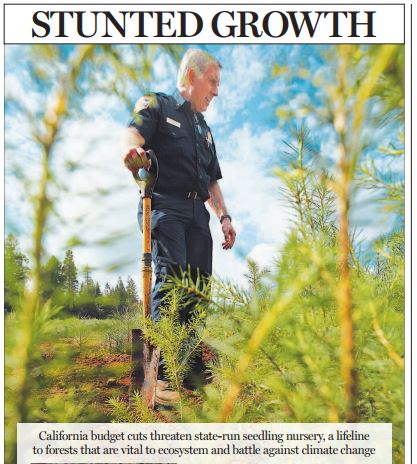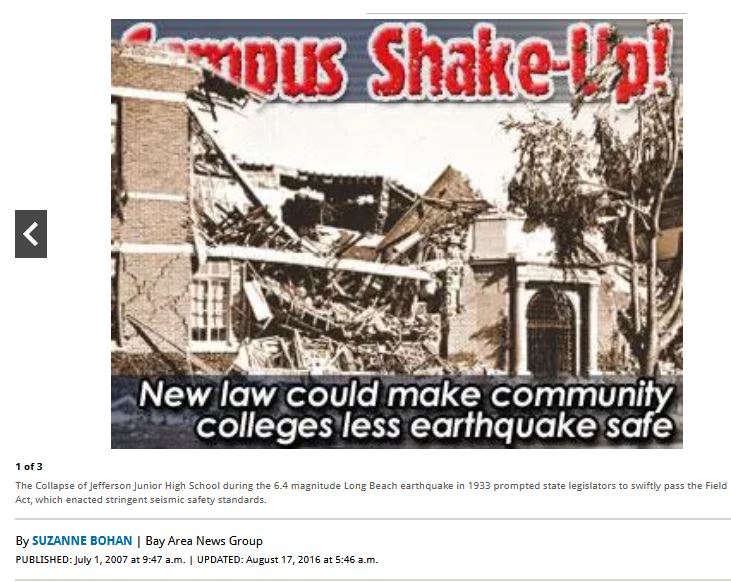Case Study: Seismic Safety In Public Schools
 In 2007, I wrote a story about the faulty activation of a high-pressure sprinkler system inside a new community college planetarium – opened just one month – which damaged $1.5 million in equipment, including a new optical star projector. An investigation found no clear cause for it, and one inspector suspected it was due to either faulty construction or design in installing the system.
In 2007, I wrote a story about the faulty activation of a high-pressure sprinkler system inside a new community college planetarium – opened just one month – which damaged $1.5 million in equipment, including a new optical star projector. An investigation found no clear cause for it, and one inspector suspected it was due to either faulty construction or design in installing the system.
Little did I suspect where this story would lead.
It was a seemingly minor issue, overall, of little interest outside a small geographic area. And the coverage would have been left at that initial article, had I not heard from a man who told me he had created an email account for a “Jack” by which to send me information. He said it wasn’t his real name, but one he wanted to use for our communications. I naturally was a little skeptical, but he clearly knowledgeable and seemingly an engineer of some sort, and I understood the need to protect his career interests. Moreover, he said he would simply provide me with information on what he considered a process, and that didn’t want to be quoted, even on background. He would provide the pointers and documents regarding a well-respected building standard in California that was becoming compromised by special interests, and which I could verify with others.
What he revealed was stunning. An obscure California Senate bill was sailing through the legislature toward approval, Jack pointed out, that would significantly lower seismic safety standards at community colleges. The administrator in charge of construction at the college with the $1.75 million sprinkler malfunction was a major supporter of this legislation.
After I reported on it, with Jack pointing me to sources of official documents, the bill quickly stalled. It suddenly had publicity, and an organized opposition quickly formed. The bill was shelved and forgotten, and community college buildings in California to this day must abide by Field Act seismic safety standards, which cost more but aims to keep school buildings standing and serving as shelters and staging areas for emergency crews immediately after a major quake
Then through a tip from another source I interviewed while researching this topic, I learned of another shocking story regarding seismic safety in K-12 public schools. Six years after the state completed an inventory of nearly 8,000 public school buildings at risk of collapse during a major earthquake – as these hadn’t been retrofitted or replaced – it was uncertain how many school districts have addressed these seismic concerns or even knew their structures are on the list. No one was monitoring it. And two years after voters passed a bond that included $200 million for retrofitting these school buildings, not a dime had been spent due to what school administrator’s called byzantine application process that sometimes led to clearly dangerous buildings nonetheless getting rejected for funding. The legislator who wrote the bill was even unaware of this funding fiasco, saying she was “shocked that money hasn’t moved into the hands of school districts to do retrofit work.”
 That led to a two-part series, “Grade for school seismic safety project? “Incomplete” and “Bay Area Schools Need Quake Proofing,” which broke the story and included the first public release of the extensive list.
That led to a two-part series, “Grade for school seismic safety project? “Incomplete” and “Bay Area Schools Need Quake Proofing,” which broke the story and included the first public release of the extensive list.
Soon after, I was contacted by reporter at the Center for Investigative Reporting (CIR) who wanted to discuss my reporting and sources, as he was going to launch a follow-up investigation into the issue. I shared a great deal of data, including the state’s spreadsheet with 8,000 at-risk school buildings, sparing him the initial effort of tracking it down. It’s not typical for reporters to share extensive sourcing for another reporter writing about the same issue, but I knew the story was suitable for far deeper inquiry and my newspaper chain unfortunately could not invest many months of my time investigating one story. They were generous enough to give me rein to research and report this two-part series, which included a live chat on first publication day.
In the interest of advancing public safety, and shining a powerful spotlight on this dysfunctional system with dangerous consequences to children and teachers, I was glad to share this complicated issue with another news organization with the resources to thoroughly investigate it, and it was gratifying to see it followed up on so quickly. (The CIR series, “On Shaky Ground,” came out after a 19-month investigation by the reporter. It led to a dramatic improvement in the seismic retrofit policy and practice at K-12 public schools, and was a Finalist for the 2012 Pulitzer Prize.)
Here are my stories on the issue:
CSM fiasco reveals oversight schism, East Bay Times
CAMPUS SHAKE UP, East Bay Times
Law changing college seismic standards on hold, East Bay Times
Grade for school seismic safety project? “Incomplete”, East Bay Times


